Tutorial: Working With Yeast
While I am not an expert at yeast by any means, I do make my fair share of yeast breads and rolls – at least several times a week. I’ve received a lot of questions lately about yeast and so I want to share with you my method of doing things. It is a wonderful feeling to whip up a batch of rolls for dinner and know that you’ve done it for at least 1/10th of the cost than at the store (and done it with fantastically delicious results!).
Here we go.
First a quick note about the difference between active dry yeast and instant yeast. These are the two main forms of yeast called for in all of my bread/roll recipes.
Active dry yeast is a dormant form of yeast and needs to be rehydrated or proofed prior to using it in a recipe. This means that the yeast needs to be dissolved in warm water (a bit of sugar helps the yeast to activate more quickly since sugar acts as a food for the yeast) and left for a few minutes to activate before using in the recipe.
Instant yeast is different than active dry yeast in that it does not need to be rehydrated or proofed prior to using in a recipe. The granules of instant yeast are smaller than active dry yeast and you can add the yeast directly in with all the other dough ingredients without letting it activate in warm water first.
Here is a visual of what yeast should look like before and after proofing.
This yeast has just been added to the water and you can still see some of the granules sitting at the top.
After about 10 minutes, the yeast/water/sugar mixture now looks like this. See how the yeast has bubbled and foamed? This is the main indicator that the yeast has properly proofed and will work in the yeast dough you are making.
Some of the yeast bread and roll recipes I have on my site call for active dry yeast, others call for instant yeast. I used to only ever buy active dry yeast but about two years ago I converted over to solely using instant yeast. For me, it is a little more foolproof because I don’t have to worry about making sure it proofs first. I use it interchangeably in recipes that call for active dry yeast. Use whatever is your preference as long as you know whether or not it needs to proof before using it.
I buy my yeast in bulk (usually at Sam’s Club or I stock up if I find it at a grocery store on sale) and when I get it home, I open a package and pour the yeast into a quart-sized jar and store it covered in the freezer. The unopened packages can be stored in a cool, dry place up until the expiration date. I pull my yeast directly out of the freezer and use it in my recipes – no need to let it come to room temperature.
When making a yeast dough, the key is probably an obvious one – the softer the dough, the more tender the resulting baked bread. This doesn’t mean your dough should be the consistency of banana bread batter. After all, flour is an important part of a yeasted dough. Instead, the dough should have a slight tackiness to it but still be pliable and smooth.
Let me show you some pictures of the process. First, I should say that my main tool in making breads and rolls is my trusty Bosch mixer. I can honestly admit I wouldn’t make yeasted goods nearly as often if I didn’t have it, BUT, I used to do it by hand all the time and I know it can be done. I just wanted to warn you that in the following pictures, you will see my beloved Bosch in action. Electric mixers are a wonderful thing, but they haven’t been around forever and I know many of you make your dough by hand.
Let’s proceed.
Here is my dough RIGHT at the point after I have added all of the flour that I think I need to make a soft dough. Do you see how it still looks slightly shaggy and sticky?
I only use the flour called for in a recipe as a guideline since so much depends on humidity, how you measure flour, etc. – so I judge my dough based on the feel and look more than on how much flour I’ve actually added. I add as much flour as I need to let the dough start pulling away from the sides of the bowl and I let it knead for a few minutes to judge whether or not I need to add more flour (I’ll also stop the mixer and pull a piece off with my fingers to judge the feel – pictures to show this are below.)
If you are making the dough by hand, add enough flour so that your dough forms a ball, even though it may be stickier than the finished product, since kneading helps to smooth things out. Also, during the kneading process the flour absorbs more of the liquid and the dough can become less sticky through kneading, which is why it is important not to overflour the dough at the beginning. You can always add more flour as you go! My dough always sticks a bit to my fingers, even once all the flour has been added.
The dough continues to knead and you can see how it is starting to look a little less shaggy. This dough has been kneading for 2-3 minutes (the equivalent of about 5-7 minutes by hand).
Finally, the dough has kneaded for about 8 minutes in the electric mixer and is smooth and ready for the first rise. Remember that it is nearly impossible to ruin a dough by over-kneading but if it hasn’t been kneaded long enough, the gluten in the dough may not develop fully and the bread may not rise and bake properly.
You’ll notice from the picture above that even though my dough has the proper amount of flour and has kneaded long enough, it is still slightly sticky – you can see it pulling on the dough hook. That is ok! I promise. The dough should still be soft and slightly tacky.
Here, I’ve pinched off a piece of the dough (this is about midway through kneading). The dough is sticking to my fingers…
But after quickly rolling it into a ball in the palm of my hand, it looks like this:
It may seem like in the first picture that the dough is way too sticky and needs more flour since it is leaving a residue on my fingers, but really, it is perfectly floured, as evidenced by the dough ball holding its shape in my hand.
After the dough has finished kneading, I scoop it into a large, greased bowl.
I cover it with greased plastic wrap and let it rise in a warm place until doubled. I never heed times on a recipe – like when a recipe says, “let dough rise for 45 minutes or until doubled.” I always judge the dough based on size not time, since every kitchen can be a different temperature.
Which brings me to another point, a warm rising spot is important. The ideal temperature for dough to rise properly is about 70 degrees or warmer. If my kitchen is a few degrees cooler than this (based on the thermostat in my house), I don’t fret too much and just assume it may take longer for the dough to rise. However, if my house is unusually cool – 66 degrees or lower, I will usually turn on my oven to about 350 degrees and let the dough rise on top of the warmed oven (I have a ceramic top stove that warms up when the oven is on).
Here is my dough at the beginning of the first rise.
After about 30 minutes, (thanks to a fast rising roll recipe due to the amount of yeast), it has definitely doubled and is ready to be shaped into rolls (or bread if that is the type of recipe you are using).
And there you have it…that is a pretty basic overview of a yeasted dough in it’s first phase. Next week, I’ll be sharing with you a tutorial on shaping this big lump of dough into rolls, including my nifty technique to get a perfectly round dinner roll.
Please let me know if you have any questions about the above tutorial. Leave your question in the comments or email me at mykitchencafe at gmail dot com.
Now go make some bread!

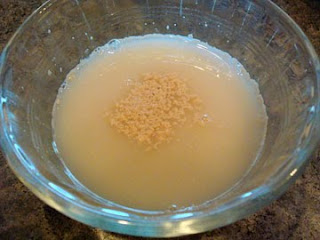
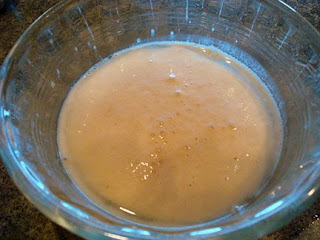
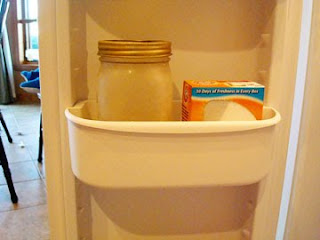
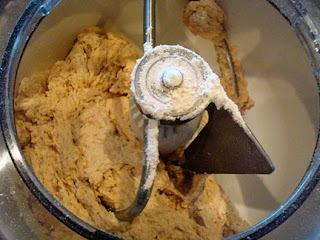

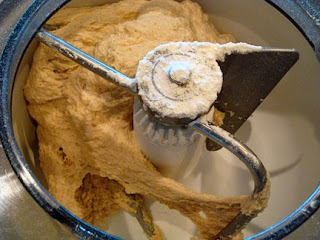
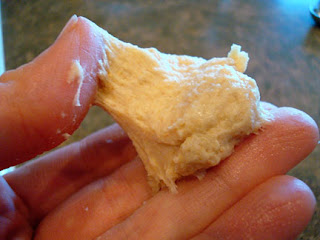
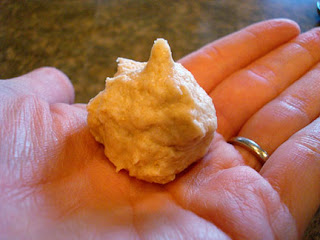
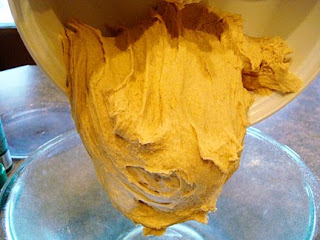
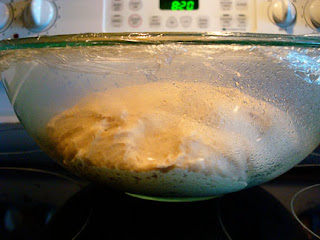
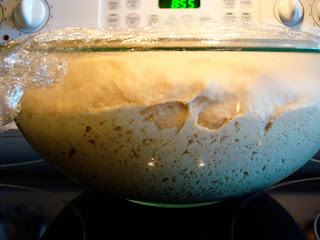
Just wondering if you have a certain brand of yeast that you prefer? Also, thank you for all the wonderful recipes. I have lots of fun browsing through your website and trying new things!
Hi Laura – I usually use the SAF brand. But if I can’t find it, I’ll grab Fleischmanns.
Hi Mel. First I want to say a Big Thank You for all your recipes & tips. Also thanks to you, I now own a Bosch Mixer! I gave my KitchenAid Mixer to my Mom (she loves it), as I feel the Bosch leaves the KitchenAid in the dust (lol) and it works so much better. I too would like to convert my recipes to incorporate the Instant Yeast. Do you have a Formula for this? Thanks 🙂
Hi Mel. It’s Chrissy again. In your Vanilla Pudding Cinnamon Rolls with Cream Cheese Frosting (recipe) calls for: 2 Tablespoons, Active Dry Yeast. Can you please tell me what the conversion would be for using Instant Yeast, instead? I went to the Fleischmann’s and Red Star Yeast, website to find an answer…but there weren’t any conversion charts. Please help….
Probably about 1 1/2 tablespoons instant dry yeast.
Thanks 🙂
I have been using Fleishman’s Rapid Rise yeast and the instructions say to dissolve in warm water between 125 and 130 degrees. Have I been doing this unnecessarily? I’d love to just be able to add liquid to the dry ingredients without getting liquid to exact temperature. Thanks so much.
I’d continue to follow the directions on the package – I’ve heard that rapid rise yeast and instant yeast aren’t the same thing (I used to think they were) and I don’t use rapid rise so I’m not sure. I know instant yeast is fine without being proofed.
Thank you so much for a great tutorial! My husband and daughter are HUGE fans of your asiago cheese bagels. All of your recipes are so clearly written and well-explained – and your photos are great too. Keep up the good work!
Thanks, Kim!
my yeast wont foam in 110 degree temp do i need to use another pkg of yeast and more warm water?
Perhaps – it’s hard to know what might be happening. You might try a different brand of yeast or make sure your yeast isn’t expired.
Thanks, very helpful.
Thank you for this wonderful tutorial! I work with the instant yeast all the time, but I am always wanting to improve. I know this will help me, because I did not know what the consistency of the dough should look like. Thank you! ☺️
Your tutorial was helpful getting yeast to rise,sugar, however I cannot get a second rise after dough has been shaped, I like the cloverleaf,. The texture is great, I have 1recipe that requires 3 eggs another 2 yet another 1, everything else is the same. Would it make a diffence if I used 2 pkgs. of yeast? thanks for any helpful hints you can provide. Beverly
Hi Beverly – sure, it might help to use a bit more yeast.
I bake rolls every week and when I started using instant yeast, I stopped the first rising of the dough. Just turn the mixed dough onto the counter and let it rest for about 5 minutes before working with it; then shape the rolls and they rise beautifully. I like to put them in a cool oven with a pan of hot water which helps them rise in about 45 minutes and the yeast doesn’t “run out”
Hi Mel. First I want to thank you for a wonderful, informative and educational website. I have learned so much from you Mel that I feel like I owe you some money for being such a great teacher LOL!
Anyway, let me start off by saying that I am new to bread making; this is all to you my dear so again, thank you for inspiring me as I do find it very rewarding, not to mention the money saved by baking your own bread/rolls. I won’t deny that I’ve had some flops, but I have always been a determined woman so I just sum it up to the learning-curve experience and carry on.
I just finished watching your videos on how to roll buns, and hamburger and hotdogs buns and I have a couple of questions. I did do quite a bit of research regarding the Bosch mixer and found that although most reviews are positive, there were concerns about cleaning the unit. You see my hands don’t work as good as they used to so I was curious about your experience with this issue. As well, I was wondering which Bosch machine it is that you use, ie. is it the Bosch Universal Plus (“BUP”) or the Bosch Compact Mixer (“BCM”). I should tell you that it is only my husband and I now so I was hoping that the BCM would be sufficient for us (I’d like to be able to do 2 loaves of bread at a time – one fresh and one for the freezer). I should also note that the reviews for the BCM were not as positive as the reviews for the BUP. As well, do you use your Bosch for any other baking, ie cakes, cookies, etc.?
I so look forward to your reply Mel – I don’t know how you manage all the work that must go into your website and juggle the responsibilities of family life, but I for one am very grateful, from the bottom of my heart.
God bless you and your family, and keep up the amazing work!
Hi Nancy! Thanks for your sweet comment! I have the Bosch Universal Mixer. I love it. Like, so, so much. I’ve only used a Kitchenaid (at other people’s homes) maybe 10-20 times so I can’t weigh the other side of the issue, but I don’t feel like the Bosch is that much more difficult to clean than other stand mixers. Except for the dough hook, I throw all the attachments in the dishwasher and usually wash the bowl by hand (it’s dishwasher safe but takes up too much room). I haven’t used the Bosch Compact mixer but if you are doing small batches, I’d probably recommend that one over the Bosch Universal (as long as the reviews lead you to believe it would be a good fit). The Bosch Universal is amazing for large batches of bread and such (I use it for cookies, frostings, quick breads, etc) but for small batches (1 loaf or a very small batch of cookies, for instance), it doesn’t perform quite as well. I hope that helps!
Thank you for your amazing tutorial.i have made your naan recipe twice and we will never buy store bought again!
This tutorial, combined with your detailed recipes has been very helpful in my efforts to make homemade breads! Thank You! I was wondering if you have any tips for baking breads at high altitude? I’m currently at 6,000 ft. above sea level. Thanks!
Hi Rachel – I used to live right around that same elevation and to be honest, I haven’t adapted my bread recipes much now that I’m at sea level (in fact most of my whole wheat bread recipes were posted when I lived at a really high elevation). You might try googling if you want specific tips, but I usually just add flour to a soft, smooth consistency and it works great.
Thank you for this tutorial!! I have been trying to make bread for years, and I always fail! I made your French bread rolls and they turned out perfectly!! Thanks so much!
So glad to hear that Melanie!
Thank you for this tutorial. It saved me from over flouring your vanilla pudding cinnamon rolls today. Taking a sticky piece off and trying to roll it into a ball was a perfect trick. Im really new at bread making so thank u for the help!
I’ve wanted to start making more of my own bread, but the process takes so long with letting the dough rise. I’d love to be able to make the dough after work one night and then bake it up after work the next night. Is there any point in the process where the dough can be refrigerated until the next day? (I see with instant yeast maybe I only need to let it rise once, so maybe that is the answer to shorten the time??)
Deanna – I haven’t tried that myself but I have refrigerated other yeast doughs without trouble. If it were me, I’d refrigerate the dough after it goes into the loaf pans. It shouldn’t overrise (hopefully) but then you could take it out and let it rise the rest of the way and bake it up. Good luck if you try it!
Referring to an earlier post, a friend of mine said that if you grind the wheat yourself, you don’t need to add additional gluten, but if you buy whole wheat flour, then the additional gluten is beneficial.
I am new to yeast products but recently (before I found your site) I decided to try to make freezer cinnamon rolls. It wasn’t Christmas yet, so I didn’t have a stand mixer (just got a brand new Bosch — ordered before I discovered this site) and had to do it all by hand.
I’ve always been a spoon & sweep girl, and the dough was really sticky as I started to knead it. I chose to knead on my pastry cloth, which really prevents putting too much flour in the dough. I didn’t know about greasing my hands, so it was a sticky mess at first. I did add more flour, little by little until it was finally only slightly stick as I kneaded, but certainly no more than an extra cup.
My goodness, those cinnamon rolls were a gift from above! The softest, most tender bread! Not good due to the butter, sugar and cinnamon alone, but the absolute best bread I’ve ever tasted in a cinnamon roll.
Now that I’ve seen your tutorial, I honestly think it’s because there was not too much flour in the dough. I guess I lucked out, but you taught me why so I now know I can repeat it. Thank you so much!
Your blog has fixed many errors of mine when it comes to bread making but the issue I’m running into now is that my bread is having troubles rising for the second time. Im not sure if this has anything to do with it but I use active yeast and I hand knead (my husband refuses to buy me a fancy mixer until I prove to him that I’ll be sticking with this hobby)
Mikayla – hmmm, do you think you are overflouring? That is a common problem with hand kneading (understandably!). Too much flour can definitely impact the dough rising. One thing that helps when kneading by hand is to coat your hands with some type of oil or cooking spray – this helps manage the dough without adding too much flour. You still may need to add a bit of flour here and there but the dough should still be very soft and smooth. I hope you can stick with it so you get that stand mixer!
Here I am, night before Thanksgiving just hoping you will read this! I knead my dough in a Kitchenaid. I always have to add more flour (I live in IL, if that makes a difference) than called for but it seems like the dough never pulls away from the bottom of my Kitchenaid bowl. It pulls away fine from the sides, but not the bottom. Do I need even more flour?
Hi Evelyn – sorry for the late response! I’ve never used a Kitchenaid to make bread/roll dough so I’m not sure if it actually will pull away from the bottom. I’m guessing it probably won’t, but if it pulls away from the sides, that should be a good indicator that your dough has enough flour (as long as it isn’t overly sticky when you press a finger into it). Let me know if you have any other questions!
Hey Mel, I have always been intimidated by yeast breads, but have recently started trying to tackle my fear. I read this tutorial and then attempted to make your vanilla pudding cinnamon rolls. They rose perfectly and looked great as I pulled them out of the oven. However, after cooling half of them went flat. Is this an indication that I used too little flour?
Question: Any tips on darn plastic wrap and spraying it to non-stick. It is such a pain to deal with. My grandmother uses shower caps to cover her foods..so i was thinking how convenient that would be to use that instead.. (if you could get it that big) any ideas or pointers to help that sort of frustration?
p.s. LOVE your site!! Ive been making all kinds of things and everything Ive made so far from your site..has never failed. You are great at explaining things and answer questions that may come up. Thank you!
Hi Stephanie – actually, I have a little trick that makes the plastic wrap not quite as painful. I lay the plastic wrap on top of the rolls – exactly how I want to cover them. Then I spray it with cooking spray and gently lift two corners and flip it so the greased side is now on top of the rolls. Lots better than holding the plastic wrap up while trying to spray (and getting grease all over your kitchen). Hope that helps!
Mel, your trick here works so well! No more plastic wrap and spray wrestling…
I was about to reorder my bulk yeast, active dry as always, when I thought – hmm I wonder if Mel has a preference? Mel to the rescue & instant yeast it shall be! You are a cooks best friend 🙂 Thanks for everything!
This post gave me horrible Bosch envy! I have wanted one for years, but I happen to have a classic Kitchen Aid instead.
Great post, I have much to learn and no one to teach it. Happy to have found your site today
Thankyou for such a thorough description of difference between instand and active dry yeast… i had by mistake bought ADY and didnt know how to use it. Aso I found it MOST helpful through photos to figure the consistancy of the dough, I was also a little unsure ofthat. I make bread using Millet and Rice Flour using the regular bread recipe, the bread comes out very nice but not as spongy looking as white bread, meaning its a bit dense, would like to make it a bit more spongy… Any ideas? More yeast? i follow Blood type B diet and dont eat wheat or corn.
Hi Tina – unfortunately, I haven’t ever made bread with millet or rice flour so I can’t give you any advice (I don’t want to steer you in the wrong direction). You might try googling and see if there are others with more experience using those types of flour. Good luck!
While it is technically not possible to over knead bread dough, it is usually a bad idea flavor-wise to do so. As you knead you introduce oxygen. As the dough gets oxygenated, it whitens. As the bread widens, it loses flavor. A better choice, usually, is to knead the bread only as much as is necessary to bring it together and then apply several folds at 30 minute intervals until the dough develops good structure. The wonderful flavor of the wheat will be preserved in this way. Happy baking!
Hi Pat – I’ve had that happen sometimes, too, and I think it could be due to a few issues – but mostly, I think that happens when the dough over-rises in the oven and then it will fall. I am very careful not to let my dough get above 1 inch (2 inches at the most) above the top of the bread pan before baking it. Anytime I let it rise longer than that, it dimples on top or falls in the middle while baking. So definitely keep an eye on that. Also, underflouring can make a dough more likely to fall while baking.
Hi Mel, I have a problem with my bread finishing raising after I put it in the pan. Sometimes it fall in the middle as it bakes. Nobody seems to know what my trouble is. Do you have any idea.
Cari – I completely understand what you are saying and I do think if you are making the dough by hand, you’ll need to add more flour. I made it by hand a month or so ago with a friend who doesn’t have a mixer and it was impossible to work with until we added 1-2 cups more flour. It might alter the texture of your bread a bit but as long as the bread isn’t overbaked, it should still come out soft and tender. Just take care not to overflour or the bread won’t rise very well. I kept greasing my hands with a bit of oil to help with the kneading.
Hi Melanie-
I currently don’t have an electric mixer of any kind. I knead my dough by hand and I know that I put in too much flour to keep it from sticking to my hands. However, I’m a little baffled how to knead dough that sticky without it being stuck all over my hands. Am I just supposed to embrace dough hands?
Thank you so much for the help! Here it is, the day before Thanksgiving and I am suppose to take rolls for our Thanksgiving lunch tomorrow. I thought it would be a good idea to make fresh rolls and now I am completely panicked. I have no clue what I am doing! This helped me so much! At least now I know that I am on the right track!
Rachel, nope, freezing the yeast doesn’t kill it. In fact it helps preserve the yeast longer…I’ve been doing it for years. It’s my understanding that it is high heat that can kill yeast mostly but frozen yeast works great.
So reading this has changed everything! I now understand what I’ve been doing wrong and I definitely was over flouring my dough! Thank you!
I have a big question though. Won’t freezing the yeast kill the yeast? I was surprised to hear that you can do this.
Thank you so much, this is absolutely the best tutorial I’ve ever had. Now I can’t
Wait to make my own rolls for my family!
Debbie – I’ve never heard that the type of bowl matters for letting yeast rise. I know with egg whites, you should avoid plastic/greasy bowls (copper works best) but I’ve used everything from plastic to glass to metal with fine results. Good luck!
First thank y ou so much for this tutorial it really helps. I have been cooking for a long long time but have not done a lot of bread and roll cooking. I made homemade soft pretzels a couple of nights ago and it is the first time that I have used dough hooks. Here is the question, I have seen so many recipes that say to let mix the yeast in a glass bowl and stir with wooden or plastic spoon and use glass bowls for rising, my mixer (nothing special) came with metal mixing bowls so am I not suppose to use these if I am mixing bread with my mixers dough hooks.
Hi Stephanie – the general rule of thumb is to use less yeast if you are using instant yeast and more yeast if you are using active dry. To make it easier to understand, if I have a packet of instant yeast that measures 2 1/4 teaspoons and I want to sub active dry yeast, I would use 3 teaspoons (equivalent of 1 tablespoon). If that same packet of 2 1/4 teaspoons was active dry yeast and I wanted to use instant yeast, I’d use anywhere from 1 1/2 teaspoons to 2 teaspoons. To be honest, I’m like you and generally just sub straight across for instant yeast and active dry – it probably won’t mess anything up – but it might create a stronger yeast taste to your dough if you use slightly too much (or if you use slightly too little, it might take longer to rise). Hope that helps a little!
Mel,
Quick question about substituting instant yeast for active. I (being completely clueless) bought a pack of yeast from Sam’s Club, it was instant yeast, and I never noticed that it said that. My sister pointed it out and told me I can’t substitute measurements exactly.
I always have and it has turned out fine (in my inexperienced bread making head anyway)
One of the recipes I use calls for 1 packet of active dry yeast, which I believe is 2 1/4 teaspoons of active dry. How much of instant should I use? This is for pizza dough.
Thanks for you help. Your tutorial on dough and flour has definitely expanded my bread making abilities.
Jill C – the doubling yeast rule is just specific to that roll recipe. I usually always double the yeast if I am doubling a recipe (unless it specifically says not to). Hope that helps!
Margie – it sounds to me like you should probably try adding more flour so the dough isn’t so sticky.
I grind my own wheat for bread making and add gluten. Wh is the dough always sticky and never leaves sides of pan?
Hi Mel, I read in one of your bread recipes that if you are going to make a double batch you shouldn’t double the amount of yeast. Do you use this as a rule of thumb for all yeast dough, or was it specific to that particular recipe? Thank you 🙂
Bonny – a metal bowl should be fine for letting the bread rise.
Does it matter if you use a metal bowl to let the bread rise in?
Hi Allison – I don’t have a kitchenaid so I’m not very familiar with the parts and what they work best with but on my Bosch mixer, I use the dough hook from start to finish. If the dough hook on your machine can mix the initial wet mixture, you should be ok to use it from start to finish also. You’ll probably have to play around with it and see. Good luck!
Hi Mel. I have a Kitchen Aid stand mixer which I have never used to make bread (nor have I made bread any other way!), but would like to try starting with your recipie for rolls. Do I use the dough hook attachment the entire time or do I start with the paddle and then change to the dough hook when it’s time to start kneading the dough? Thank you for any advice you can offer.
I’m so glad you posted this! For a long time, I had this HUGE fear of over-kneading my dough. The thought of running my KitchenAid for 5-7 minutes almost made me a nervous wreck. I thought every time I had tough rolls/bread, it was because of over-kneading. After reading this it dawned on me — my problem wasn’t over-kneading, it was over-flouring! What a relief to my mind, and such a quick fix thanks to your photos. Thank you Mel!
Hi Sarah – thanks for the comment! If your dough is that sticky, it says to me that you definitely need to add more flour. It should easily clear the sides and middle of the bowl while still retaining a tacky, slightly sticky feel, but it shouldn’t leave much residue on your hands or fingers. Add more flour, about a 1/4 cup at a time and see if that helps!
First, I have to say I love your website! I usually cook something from your recipe index 5 out of 7 days a week. I love that if it’s on your site, I know it will taste great – no more guessing when trying a new recipe. ANYWAY, I have a question about the yeast dough even after reading your tutorial. My dough is sticky, sticky, STICKY. – I lose half of it to the mixer bowl and to my hands because it is out of control sticky. What causes this? Do you think this is a result of too much or too little flour?
Thank you so much for this tutorial! My nagging question about where to let my bread rise was answered! I always felt like my dough didn’t rise the way it should and wondered if my kitchen was too cold. And apparently, I’ve been adding too much flour. Now…to go test out my new bread knowledge~bread bowls and Broccoli Cheese soup…I’m channeling Panera 🙂
I didn’t realize my active dry yeast had to be refridgerated after opening. If it’s been in my kitchen for a week without being in the fridge, is it still safe to use? Thanks for all the info, I’m excited to try more bread recipes!!!
Hi Melanie, i am new to your site (as of about a few months ago). Love your recipes. I am currently living in Munich Germany so some ingredients are tricky to find. Luckily I canimprovise pretty well. I did fine a yeast here called Hefe. Its a dry packet with tiny granules. the other option was the cube in the fridge section by the butter and lard. Which one do you suggest I use? I dont normally do homemade yeast bread but today Im desperate cuz everything is closed on Sunday here and tomorrow is school. I had the same issue when we lived in Italy for 2 years……..its exhausting.